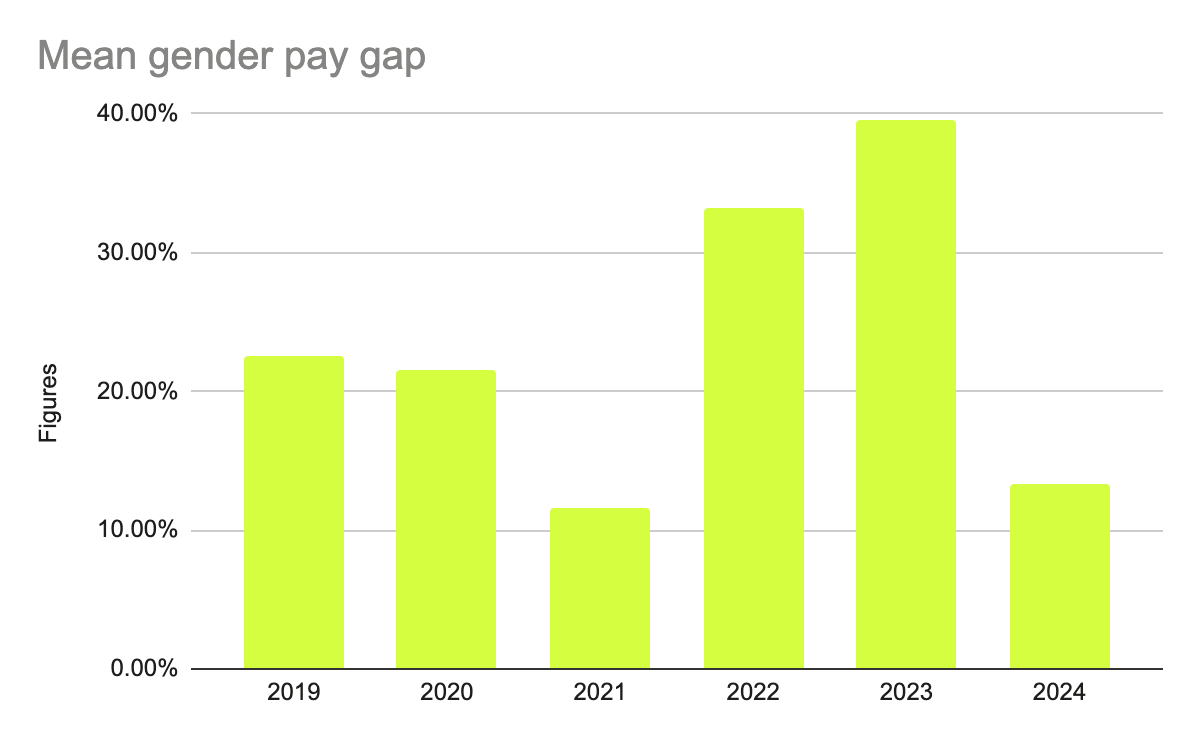
Reddico Gender Pay Gap Report 2024
Welcome to Reddico’s second gender pay gap report.
Let’s start by answering a key question: why are we doing the report again after three years?
To understand how things have changed since 2021. We have a continuous commitment to make the company more inclusive and we want to see how this has developed over a longer period of time.
To be transparent. We pride ourselves on being open and honest and taking accountability.
To plan our next steps. We strive for improvement — knowing what we can do better helps us work out how to get there.
Executive summary
Our mean gender pay gap is 13.38%, down from 39.6%.
Our median gender pay gap is 13.65%, down from 34.01%.
While it’s difficult to measure the gender pay gap across the SEO industry as a whole, a report into the gender gap in SEO publishing found that 64% of articles written in 2023 on SEO publications were written by men, compared to 36% written by women. While this is an improvement on last year’s figures (70%/30%), it shows how male-dominated the SEO industry is. This disparity can prevent progress in closing the gender pay gap.
Note: All data and information correct as at June 2024.
 What is the gender pay gap?
What is the gender pay gap?
Historically, there’s always been a difference between the average hourly earnings of men and women. This is known as the gender pay gap, and there are several reasons why it still exists today.
In general, women are still more likely to work part-time roles due to having children or because they’re caring for elderly relatives. Since our last report in 2021, the numbers have remained similar, but there has been a slight increase in the amount of men working part time. 38% of employed women in the UK work part time, compared to 14% of men. This is likely a result of companies adopting more flexible working policies, allowing men and women to share child-rearing duties and achieve a better work/life balance.
Women are still more likely to work in lower-paying roles, whereas men are more likely to work in senior roles. While the number of women in senior roles is rising, currently 34% globally, experts believe that ‘women’s parity in senior management won’t be reached until 2053 at the current rate’.
Other reasons why a gender pay gap exists:
Women still often face discrimination for having children whilst holding down a career. A study in 2023 found that 52% of mothers say they faced some form of discrimination at work when pregnant, on maternity leave or when they returned, while 74% said that someone had insinuated their performance dropped as a result of their pregnancy or maternity leave.
Women are more likely to be carers than men — of the five million people providing unpaid care in England and Wales, 59% are female, compared to 58% in 2022.
The most recent statistics on the gender pay gap in the UK show that the gap is slowly closing, but experts warn that the figures from recent years are likely to have been affected by the Coronavirus pandemic, so it’s recommended to view the gap as a long-term trend.
Covid initially increased the gender pay gap, as many part-time roles in hospitality, childcare and retail were lost – predominantly female workers. But in the wake of the pandemic there is hope that proof of how effective flexible working can be will continue to close the gap.
The gender pay gap for full-time employees has decreased from 17% in 1997 to 7.7% in 2023.
Employees | UK gender pay gap in 2022 | UK gender pay gap in 2023 |
Full-time employees | 8.3% | 7.7% |
All employees | 14.9% | 14.3% |
How is it calculated?
There are multiple ways to calculate a gender pay gap. Like last time, we’ll focus on the mean gender pay gap and the median gender pay gap.
Calculating the mean gender pay gap
Add the hourly pay of all full-pay male employees and divide by the total number of those male employees. This figure is the mean male hourly pay rate.
Add the hourly pay of all full-pay female employees and divide by the total number of those female employees. This figure is the mean female hourly pay rate.
Deduct the mean female hourly pay rate from the mean male hourly pay rate.
Divide the result by the mean hourly pay rate.
Multiply the resulting figure by 100.
Using a hypothetical example, a company might employ 10 men for a total hourly pay of £300, and 12 women for a total of £275.
In this instance, the following calculations would be made:
300 / 10 = 30 (the mean male hourly pay rate)
275 / 12 = 22.91 (the mean female hourly pay rate)
30 - 22.91 = 7.09
7.09 / 26.13 (the total mean hourly pay rate at the company) = 0.2713
0.2713 x 100 = 27.13
In our example, the mean gender pay gap would be 27.13%.
Calculating the median gender pay gap
Identify the hourly rate of pay at the midpoint of all full-pay male employees to get the median male hourly pay rate.
Identify the hourly rate of pay at the midpoint of all full-pay female employees to get the median female hourly pay rate.
Deduct the median female hourly pay rate from the median male hourly pay rate.
Divide the result by the median male hourly pay rate.
Multiply the resulting figure by 100.
Let’s say the median female hourly pay rate at a company is £20, and the median male hourly rate is £22. The calculation we’d use here would look as follows:
22 - 20 = 2
2 / 22 = 0.0909
0.0909 x 100 = 9.09
As such, the median gender pay gap in this scenario would be 9.09%.
How is it different from pay inequality?
Although the two can be easily confused, the gender pay gap is not a result of pay inequality. The gender pay gap is a measure of the difference between the average earnings of both men and women, and is expressed as a percentage of men’s earnings.
In contrast, equal pay addresses the need for two people in the same role, performing equally, to be deserving of the same pay — regardless of gender.
Therefore, even if a company pays all employees equally, they could still have a gender pay gap if there are more men in higher paying positions or more men than women in full-time roles.
The Reddico gender pay gap
Female employees | Male employees | Mean average | YOY change | Median average | YOY change | |
2022 | 17 (+6) | 22 (+8) | 33.18% | Up 21.56 | 20.73% | Up 3.8 |
2023 | 21 (+4) | 15 (-7) | 39.6% | Up 6.42 | 34.01% | Up 13.28 |
2024 | 19 (-2) | 13 (-2) | 13.38% | Down 26.22 | 13.65% | Down 20.36 |
Analysis
Our gender pay gap fell in 2024 for two reasons:
The Reddico founders and previous directors left the company
More women have been promoted to senior roles, bringing us closer to our 2021 figures
The rise and fall of the figures is the result of structural changes within Reddico after we joined Sideshow Group in late 2021.
It’s worth noting that SEO is a traditionally male dominated industry, and tends to have higher marketplace pay rates than other areas in the business. Women in Tech SEO note that fewer opportunities are presented to women venturing into the field after graduation, and a small percentage of women in tech making it to a top position. Women leave the tech industry at a 45% higher rate than men.
Our SEO team is 77.8% male and 22.2% female. Our female SEOs are seniors, showing that the opportunity for progression is there. We hope that, over time, we can recruit more female SEOs of all levels and give them the chance to develop their careers with us.
“Although our gender pay gap has remained on par with the previous report in 2021, as a business I believe we can be proud of the strides we have made in supporting and championing women at Reddico,” says Luke Kyte, Operations Director. “We've continued to ensure our policy list is both thoughtful and inclusive, and adjusted our recruitment process to create a fairer structure.
“It's incredible to see the number of women who have been promoted over the last three years, and we now have a 50/50 split between men and women in leadership positions. There are also more women at Reddico than men. This is a stark contrast from years gone by, where Reddico, like much of the SEO world, was typically a male-dominated environment.”
Our gender pay gap over time
 Leadership team
Leadership team
Compared to our last report in 2021, where there were four men and two women, Reddico’s leadership team now consists of three people:
Chris Pitt (Managing Director)
Luke Kyte (Operations Director)
Vicki Salih (Finance Director)
Women in senior roles
We currently employ 11 women in senior roles:
Vicki Salih (Finance Director)
Eva Mermingi (Senior Technical SEO Consultant)
Eleanor Reynolds (Senior SEO Consultant)
Holly Jackson (Content Lead)
Beth Tolson (Senior Content Writer)
Holly Yelland (Senior Designer & Developer)
Laura Tyler (Delivery Lead)
Amber Heryet (Senior Project Manager)
Blazka Poklic (Senior Project Manager)
Nikki Larter (Finance Manager)
Laura Clews (HR & Recruitment Manager)
This is an increase from 2021’s total of five, with the number of women in senior roles more than doubling.
64.7% of female employees are in a senior role. In total, women hold 50% of the senior roles at Reddico.
Our approach to diversity and gender equality
Reddico has always prided itself on being an inclusive place to work, and recognises the benefits of having a diverse workforce. We are committed to ensuring no one suffers from discrimination, either directly or indirectly, and seek to promote the principles of equality and diversity in every aspect of our workforce.
Recruitment
During the recruitment process we use blind CVs, which means the names are removed before anyone sees them. The idea is to remove any conscious or unconscious bias around characteristics such as gender, and ensure focus is on the candidate’s qualifications and skills.
Flexibility
Remote working and flexible working allows all team members to maintain a fulfilling work/life balance. Women often juggle multiple responsibilities alongside full-time roles, so flexibility is essential.
The team are given the freedom to choose their own working hours, allowing them to work from anywhere in the world and to fit a variety of different lifestyles around their roles. For single mothers especially, this flexibility offers a rare opportunity to work full-time whilst managing childcare and household responsibilities – something that just isn’t possible in many other companies.
Of course, to ensure everyone can work to suit their needs and still produce high-quality work, communication is key. Our teams are experts at cross-collaboration and supporting one another, in a way that helps everyone achieve a positive work/life balance.
Remote working
We’ve had a remote-first policy since 2020, after the pandemic shifted our way of working. This allows us to recruit from further afield, with the team able to choose where they work from. We became fully remote in August 2023 when we closed our Tonbridge office, but maintain our connections through good communication and regular all-team catch-ups and social events, both on and offline.
Quotes from the team
Vicki Salih:
I am proud of how we are working towards closing the gender pay gap within Reddico, and excited to see how we continue to close the gap as we work closer with the other agencies in the Sideshow group in the future. We now have an equal split of men and women in senior/lead roles within the team, and we continue to celebrate inclusion by offering two salary reviews per year in which anyone can apply for an increase. As a member of the Living Wage Foundation, we are proud to ensure all employees earn a wage which is enough to live on.
Jessica Plumtree:
It’s clear (even from the fact that this report is published) that Reddico is committed to understanding how they can better support all employees across the business, regardless of their gender, which is great to see. The policies we have in place are designed to help as many people as possible, and address everyday things such as menstruation pain and menopause – something that is often taboo in other companies, but understandably can affect how you’re feeling at work.
Having a clear career matrix means that I can be sure that me and my colleagues are all being assessed against the same criteria when it comes to promotions or pay rises, without bias. Plus, flexible working as standard means that I’m able to balance my other responsibilities without feeling like I’m going to be viewed negatively for stepping away from my desk, whatever the reason.
Lola Cofek:
I’ve never felt that gender is a barrier to progression at Reddico, likely because we have so many women in senior roles. It’s encouraging and inspiring.
Eva Mermingi:
I've never felt unequal in any way, shape, or form here, which has been a game-changer for me. Thanks to our inclusive culture, I've been able to shine bright and freely pursue my passion without any roadblocks. It's like working in an environment where everyone's superpowers are celebrated, regardless of gender. Kudos to us for making equality not just a policy, but a practice!
Holly Jackson:
I find it really encouraging that Reddico is committed to monitoring trends in our gender pay gap. This is now our second report and it’s positive to see that gap closing over time.
Salary bands
Many departments across Reddico have a career matrix, which openly aligns the skills, experience and knowledge the team needs to progress in their roles. This matrix is aligned with thorough marketplace research, which provides a breakdown of the expected salary someone would earn based on their role in the company (and the wider digital world). We refer to these breakdowns as salary bands.
Salary bands ensure we have no issue with equal pay, because each individual is paid according to their role and career matrix. All salaries are regularly reviewed across the board to ensure fairness throughout the company.
We have recently implemented feedback to improve this system further, bringing all our training and development documents into one hub so it’s easier for the team to track their progress. Each team member now has a quarterly appraisal where they review the tasks and competencies on their matrix with their department lead and make a plan for their next steps. This helps them to know where they’re at and what they should earn, as well as indicating when a promotion is likely.
International Women’s Day
Recently, we interviewed multiple members of our team to get their views on gender inclusion at Reddico, in honour of International Women’s Day. The answers clearly celebrated our commitment to equality, and show how Reddico empowers women to reach their full potential in their careers without any gender bias boundaries. Team members stated that “even as a junior, there was no bias because of my gender or experience level – my team has always been open to new ideas” and, as one employee said, “it's not about gender; it's about vision.”
Policies
Maternity leave
When we updated our maternity leave policy we decided to offer 100% of the individual’s salary for the first 12 weeks. Research shows that motherhood can contribute towards the gender pay gap — we want mothers to be able to focus on their newborn without worrying about their earnings.
Time period | Standard policy | Reddico policy |
First 6 weeks | 90% of your salary | 100% of your salary |
Next 6 weeks | Statutory payment (£151.97 or 90% of your average weekly earnings - whichever is lowest) | 100% of your salary |
Next 27 weeks | Statutory payment | Statutory payment |
Final 13 weeks (optional) | Unpaid | Unpaid |
Paternity leave
Fathers with newborns can take up to four weeks of paid paternity leave following the birth of their child, compared to the UK standard of one or two weeks. This gives them longer to adjust to fatherhood, support their partner, and bond with their baby.
They’re not under any obligation to take this, and can choose the amount of time that suits their circumstances.
Adoption leave
If someone at Reddico adopts a child, they or their partner will be eligible for adoption leave. Adoption leave can be taken by either partner adopting a child jointly, regardless of gender.
If the person employed by Reddico decides to take adoption leave the terms are in line with our maternity leave policy.
Losing a child during pregnancy
Sadly, pregnancy loss is more common than people realise:
Over one in five pregnancies end in miscarriage
One in 250 births in the UK are stillbirths
One in three women in the UK will have an abortion by the age of 45
In 2021 we updated our handbook to include a specific policy around losing a child in pregnancy. We’re committed to supporting all team members, whether it happens directly to them, their partner or the baby’s surrogate, regardless of the nature of the loss.
Periods, perimenopause and the menopause
There are a number of reasons someone may be affected by hormonal changes and symptoms that leave them unable to work. Since our last gender pay gap report we’ve introduced a policy to support people who have periods, or who are going through perimenopause or the menopause. This policy is inclusive of women, transgender and non-binary people.
Periods: The part of the menstrual cycle when the uterus sheds its lining.
Perimenopause: When someone has symptoms of menopause but their periods haven’t stopped.
Menopause: When someone’s periods stop due to lower hormone levels. This usually happens between the ages of 45 and 55, but it can happen earlier.
Policies we offer that can be used to support menstruation, perimenopause and menopause:
Flexible working: The team are encouraged to work at times that are right for them, with no restriction to the hours they work. The option is there if they need to take time out.
Mental health support: Our mental health support, Core Collective, allows the team to arrange confidential calls with a trained therapist on any topic they want. The therapist can offer dedicated support and advice.
Annual leave and sickness: There’s no restriction on the number of annual leave days the team can take, so if they need time out of work to focus on their health and wellbeing they can do so. They can also take paid sick days if they’re in a position where work isn’t possible at short notice.
Support from HR: There’s no requirement for anyone to talk openly about their health challenges. However, speaking to an HR representative can ensure they have the additional support they need, if they feel comfortable doing so.
Conclusion
With a mean gender pay gap of 13.38%, we are ahead of the UK average of 14.3%. But that’s not a reason to be complacent — there’s still plenty we can do.
“Whilst things aren't perfect, we're certainly on the right path. And this is epitomised by the team's perspective, with women across the company sharing their thoughts in this report.”, says Luke. “Ultimately, we want to create a great working environment for everyone with equal opportunity, so to see this recognised and acknowledged by the team demonstrates our progress and commitment.
“In terms of the future, as we get closer to Sideshow Group and become more connected with our sister agencies, we'll find opportunities to bridge the current gap. For instance, at More2 there is an active Diversity & Inclusion group that is continually looking at education and new approaches.
“However, the biggest challenge remains the gap in senior women in the SEO team. We have a brilliant team in place, though recruitment is typically dominated by male applicants. Understanding how to change this, and launching new initiatives to support diversity in applications, is a must going forward.”
Sign-up to Reddico News
To keep up-to-date with the latest developments in the world of SEO, our insights, industry case studies and company news, sign-up here.




